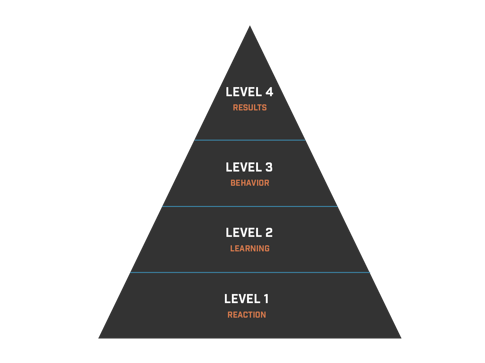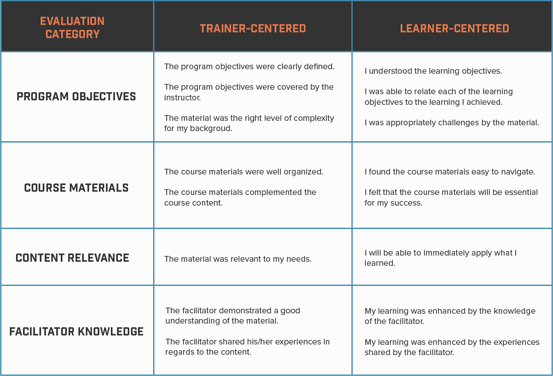
The Kirkpatrick Model is a globally recognized method of evaluating the results of training and learning programs. It assesses both formal and informal training methods and rates them against four levels of criteria: reaction, learning, behavior, and results.

The first level of criteria is “reaction,” which measures whether learners find the training engaging, favorable, and relevant to their jobs. This level is most commonly assessed by an after-training survey (often referred to as a “smile sheet”) that asks students to rate their experience.
A crucial component of Level 1 analysis is a focus on the learner versus the trainer. While it may feel natural for a facilitator to fixate on the training outcome (such as content or learning environment), the Kirkpatrick Model encourages survey questions that concentrate on the learner’s takeaways.

Level 2 gauges the learning of each participant based on whether learners acquire the intended knowledge, skills, attitude, confidence and commitment to the training. Learning can be evaluated through both formal and informal methods, and should be evaluated through pre-learning and post-learning assessments to identify accuracy and comprehension.
Methods of assessment include exams or interview-style evaluations. A defined, clear scoring process must be determined in advance to reduce inconsistencies.
One of the most crucial steps in the Kirkpatrick Model, Level 3 measures whether participants were truly impacted by the learning and if they’re applying what they learn. Assessing behavioral changes makes it possible to know not only whether the skills were understood, but if it's logistically possible to use the skills in the workplace.
Oftentimes, evaluating behavior uncovers issues within the workplace. A lack of behavioral change may not mean training was ineffective, but that the organization’s current processes and cultural conditions aren’t fostering an ideal learning environment for the desired change.
The final level, Level 4, is dedicated to measuring direct results. Level Four measures the learning against an organization's business outcomes— the Key Performance Indicators that were established before learning was initiated. Common KPI’s include higher return on investments, less workplace accidents, and larger quantity of sales.
Using the Kirkpatrick Model creates an actionable measurement plan to clearly define goals, measure results and identify areas of notable impact. Analyzing data at each level allows organizations to evaluate the relationship between each level to better understand the training results— and, as an added benefit, allows organizations to readjust plans and correct course throughout the learning process.
If your organization is ready to take the next step in learning, send us a message! Ardent’s team of experts will walk you through viable solutions, and discuss how to use the Kirkpatrick Model to get the results your team needs.
These Stories on Industry Insights
One of the most impactful emotional intelligence (EI) activities ...
I’m willing to bet that most of you ...
When someone asks me what my favorite season is, it’s an easy answer: football season. Aside from just being a sports fan in general, I love the competitive energy, the team spirit, and the ...
Copyright © 2025 Ardent Learning Inc. All Rights Reserved.